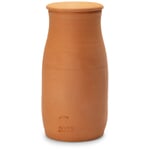Watering pot for flower beds

Watering pot for flower beds
- Water less frequently even on hot, dry summer days
- Saving water through reduced evaporation and seepage losses
- Water delivery arrives directly at the root area
General Information
Hand potted. A water reservoir for your flower beds
The principle has been known for thousands of years. A vessel made of low-fired, porous clay is buried in the ground and filled to the brim with water. As soon as the clay surface is saturated, the stored moisture is released to the outside as required. This means you can ensure your plants are supplied with water even on hot, dry summer days - without having to connect the garden hose or fill the watering cans every evening. With its protruding, bulbous shape, this version of the watering pot is primarily intended for use in open beds. It is easy to use: choose a place near the plants that you need to water very frequently. In the vegetable patch, for example, these are tomatoes, cucumbers and zucchinis. Dig the pot in so that its narrow end, including the opening and lid, does not protrude more than one or two centimetres out of the soil and put the lid on after filling with water so that the contents remain clean. To get the watering effect going, it may be necessary to water the surrounding area thoroughly first. As the soil begins to dry out, water will run out of the clay pot - always just as much as is needed at that moment to restore balance. Once this is achieved, the flow of water stops and the cycle starts all over again.
Good for your plants
Plants benefit from this ancient idea of using a clay pot (Spanish "olla") for irrigation, as they receive their water supply primarily in the root area. This additionally stimulates root growth - and the more stable and healthy a plant's roots develop, the less susceptible its foliage, flowers and fruit will be. And the deeper the root system branches downwards, the more drought-resistant the above-ground parts of the plant become. Another advantage: this watering method generally attracts fewer snails because the soil surface in the bed remains largely dry. As the foliage of the plants does not come into contact with water either, the leaves are hardly susceptible to fungal diseases over the course of the season. In general, watering from below results in measurably less evaporation and seepage losses than traditional watering. This means you can even save water. Our tip: Cover the beds with an additional layer of mulch, for example lawn cuttings, nettle leaves or shredded material, to keep the moisture in the soil even longer.
Product Information
Article Number 206318
- Water less frequently even on hot, dry summer days
- Saving water through reduced evaporation and seepage losses
- Water delivery arrives directly at the root area
Terracotta unglazed, 2-piece. Low-fired and therefore water-permeable. Volume approx. 2.5 l. Opening Ø 9 cm, belly Ø 13 cm, height 26 cm. Weight 1.6 kg. Handmade, so dimensions may vary slightly. The manufacturer recommends using one pot per approx. 1.5 m² of bed area. For larger areas and plants with increased water requirements, it is therefore better to allow for more than one pot and also consider the location of your beds when planning. Plants generally need more water in full sun than in shade or partial shade. Note: Please remove your watering pots from the beds at the end of the season.
Have a question?
If you have a question concerning this product you are welcome to contact us. For this your E-Mail program will open.
Contact Us
For advice, spare parts or special requests - our customer service will take care of your questions and concerns, personally and competently.
You can reach us from Monday to Friday at +49 2309 939095 or anytime at info@manufactum.com
Gift Certificates
It is good for everything: With our PDF gift certificates you can choose from the entire Manufactum selection. Pick a motif which you can send by email or print out and present personally, immediately after submitting your order.
Order now


